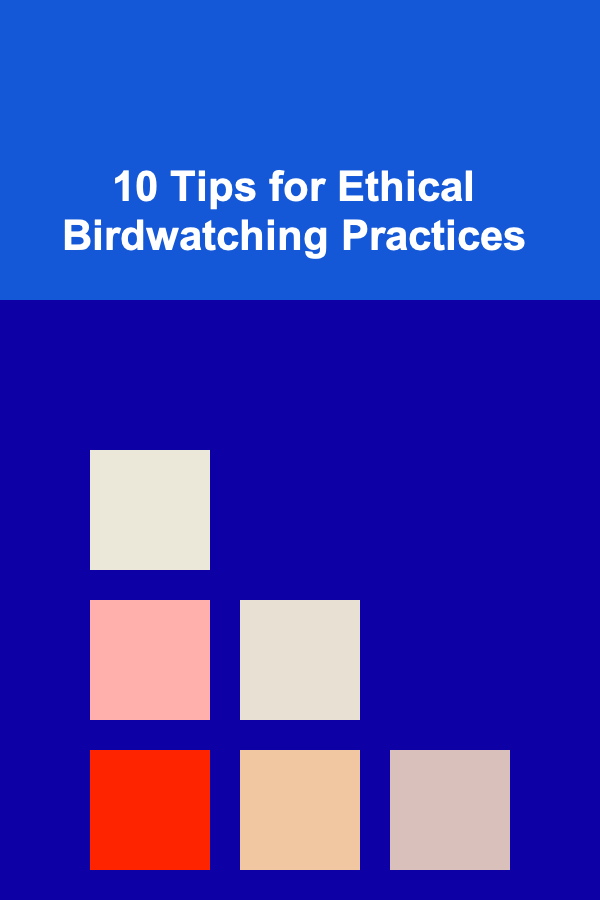
10 Tips for Ethical Birdwatching Practices
ebook include PDF & Audio bundle (Micro Guide)
$12.99$8.99
Limited Time Offer! Order within the next:

Birdwatching, often referred to as birding, is a rewarding activity that connects people with nature, encourages conservation efforts, and fosters a deeper understanding of wildlife. However, with the growing popularity of birdwatching, it is essential that birders engage in the practice ethically to minimize disturbances to birds and their habitats. Ethical birdwatching not only ensures the protection of birds but also promotes responsible behavior among the birdwatching community.
In this article, we will discuss 10 important tips for ethical birdwatching practices that every birder, novice or experienced, should follow. These guidelines will help ensure that your birdwatching adventures are not only enjoyable but also respectful of the animals you observe and their ecosystems.
Respect Wildlife and Their Habitats
The first and most fundamental rule of ethical birdwatching is to respect the wildlife you are observing. Birds are not there for your entertainment; they are living creatures with specific needs and behaviors. Observing them from a distance and avoiding any actions that disrupt their natural behavior is critical for their well-being.
How to Respect Wildlife:
- Stay at a safe distance: Use binoculars or spotting scopes to observe birds rather than approaching them closely.
- Avoid disturbing nesting sites: Never get too close to active nests, especially during breeding season. Disturbing these sites can lead to nest abandonment or reduced reproductive success.
- Do not attempt to feed birds: While it may be tempting to offer food, feeding birds can disrupt their natural foraging behaviors and make them reliant on human-provided food sources.
By respecting wildlife and their habitats, you contribute to their conservation and minimize your impact on their environment.
Stick to Established Trails and Paths
When birdwatching in natural areas such as forests, wetlands, or national parks, it is crucial to stick to established trails and paths. Venturing off these trails can cause damage to delicate ecosystems, disrupt wildlife, and contribute to soil erosion. By following designated paths, you can help preserve the integrity of the habitat.
Benefits of Staying on Trails:
- Reduces damage to vegetation and nesting habitats.
- Prevents accidental encounters with sensitive or endangered species.
- Helps prevent the spread of invasive plant species that can be introduced through trampling.
Whether you're hiking or birding in a local park, always remain on trails to ensure that the area stays pristine for future generations of birdwatchers and wildlife.
Minimize Noise and Movements
Birds are highly sensitive to noise and sudden movements. Loud talking, shouting, or even abrupt physical movements can startle birds, potentially causing them to fly away or abandon their nests. Ethical birdwatching involves minimizing your presence and making sure that your actions do not disturb the birds.
Tips for Reducing Noise and Movements:
- Speak in low tones: If you are birdwatching with others, keep conversations quiet and respectful.
- Slow, deliberate movements: Avoid quick or jerky motions that could catch a bird's attention and cause alarm.
- Turn off electronics: Loud cameras, cell phones, or other electronic devices can create noise that disturbs birds. Keep your gear on silent or at a low volume.
By maintaining a quiet and calm demeanor, you'll be able to observe birds more effectively without causing them stress.
Avoid Crowding Birds
Birds, like all wildlife, need their space. Crowding a bird, especially if it's feeding, nesting, or resting, can cause unnecessary stress and even force it to flee. Ethical birdwatching practices involve respecting birds' personal space and being mindful of their behavior.
How to Avoid Crowding Birds:
- Maintain a reasonable distance: Use binoculars, scopes, or cameras with zoom lenses to observe from afar.
- Watch for signs of distress: If a bird seems agitated or begins to fly away, that's a signal that you are too close. Always back off.
- Be aware of other birdwatchers: If you are in a group, ensure that everyone respects the space around the bird.
By giving birds the space they need, you allow them to behave naturally without unnecessary disturbance.
Do Not Harass or Chase Birds
It can be tempting to try and get a closer look at a bird by following it or even trying to "flush" it out, but this behavior is highly unethical. Chasing birds or causing them to fly unnecessarily can be exhausting for them, especially during migration or breeding seasons. Birds need to conserve their energy for foraging and survival, and harassing them can interfere with their natural behaviors.
How to Avoid Harassment:
- Never chase after a bird or attempt to get it to fly.
- Observe birds from a distance and be patient. If a bird is moving, respect its space and allow it to fly freely.
- Refrain from using recorded calls to lure birds out of hiding. While some birders use calls to attract birds, this practice can be harmful if done excessively or with the wrong species.
Chasing or harassing birds not only disrupts their activities but also affects their overall health and safety.
Be Mindful of Breeding Seasons
The breeding season is an especially sensitive time for birds. Nesting birds are often more vulnerable to disturbances, and an intrusive observer can cause the parents to abandon their nests, leading to the death of eggs or chicks. Ethical birdwatching means being extra cautious during these months, ensuring that your presence does not interfere with the breeding process.
How to Be Mindful of Breeding Seasons:
- Avoid areas known for nesting birds, especially in spring and summer.
- Learn to recognize and avoid critical habitats such as wetlands and dense forests, where many species nest.
- If you spot a nest, keep a respectful distance and do not linger nearby.
Taking extra care during breeding seasons helps ensure that birds can successfully raise their young without unnecessary disturbances.
Protect Sensitive and Endangered Species
Some bird species are particularly vulnerable, and ethical birdwatching requires extra attention to the needs of these birds. Disturbing an endangered species can have severe consequences, such as pushing them closer to extinction. Always be aware of the species you are observing and take appropriate steps to protect them.
How to Protect Sensitive Species:
- Familiarize yourself with local endangered species: Know which birds in your area are endangered or threatened and ensure that you are not disturbing them.
- Follow legal guidelines: Many regions have specific laws or regulations regarding the protection of wildlife. Always adhere to these guidelines when birdwatching in protected areas.
- Avoid popular hotspots for rare birds: Some bird species are particularly sensitive to human activity, so it's best to avoid crowded birdwatching locations when you know that a rare species is present.
Protecting sensitive species ensures that future generations of birdwatchers will continue to have the opportunity to experience these remarkable creatures.
Use Ethical Photography Techniques
Birdwatching often goes hand-in-hand with bird photography, but it's important to be mindful of the ethical considerations when capturing images of birds. Photography should not be done at the expense of the bird's well-being. Overzealous photographers sometimes put birds in stressful situations for the sake of a good shot, but this is highly unethical.
Ethical Bird Photography Tips:
- Use a long lens: Avoid getting too close to birds by using a zoom lens that allows you to take photos from a safe distance.
- Do not use flash photography: Flash can startle birds, especially in low-light conditions. Always turn off your flash.
- Respect the bird's behavior: If a bird shows signs of distress, stop taking pictures and give it space.
By following ethical photography practices, you help ensure that your passion for capturing nature does not harm the very creatures you admire.
Leave No Trace
Ethical birdwatching goes beyond simply respecting the birds and extends to the environment as a whole. Always follow the principle of "leave no trace," which involves minimizing your impact on the natural world. This includes picking up after yourself, avoiding littering, and ensuring that you do not damage vegetation or other natural resources.
How to Leave No Trace:
- Pack out all trash: Ensure that you take all trash with you, including small items like food wrappers or cigarette butts.
- Avoid disturbing plants and vegetation: Refrain from stepping on fragile plants or disturbing the soil.
- Do not remove plants or wildlife: Never collect specimens, such as feathers, nests, or flowers, from the wild.
By leaving no trace, you help preserve the habitats that make birdwatching possible for everyone.
Support Conservation Efforts
Finally, one of the most important ways to engage in ethical birdwatching is to support conservation efforts. Many birds are threatened by habitat loss, pollution, climate change, and other human activities. By contributing to conservation initiatives, you can help protect the birds and ecosystems that you love to observe.
Ways to Support Bird Conservation:
- Donate to bird conservation organizations: Many groups work tirelessly to protect bird species and their habitats. Your financial support can make a difference.
- Volunteer for bird conservation projects: Get involved with local bird conservation initiatives by volunteering your time.
- Promote habitat protection: Support policies and initiatives that protect natural habitats and create safe spaces for birds to thrive.
By supporting conservation efforts, you contribute to the long-term survival of bird species and their ecosystems.
Conclusion
Ethical birdwatching is about more than just following rules; it's about fostering a deep respect for birds and the environment. By adhering to these 10 tips for ethical birdwatching practices, you can enjoy the wonders of birding while ensuring that birds and their habitats are protected for generations to come. Whether you're a beginner or an experienced birder, practicing ethical birdwatching helps preserve the beauty of nature and the joy of birdwatching for future enthusiasts.
Reading More From Our Other Websites
- [Personal Investment 101] How to Leverage Social Trading Platforms to Diversify Your Portfolio Responsibly
- [Ziplining Tip 101] Soaring Above the Rapids: A First-Timer's Guide to River Ziplining
- [Trail Running Tip 101] Seasonal Gear Guide: Staying Safe and Comfortable in Hot, Cold, and Wet Conditions
- [Home Security 101] How to Improve Home Security with Smart Technology
- [Rock Climbing Tip 101] Gear & Nutrition Hacks: Optimizing Equipment and Diet to Elevate Your Climb
- [Personal Care Tips 101] How to Pick a Toothbrush That Fits Your Mouth Size
- [Personal Financial Planning 101] How to Invest in ETFs for Beginners
- [Personal Finance Management 101] How to Build a Healthy Credit Score in 6 Months
- [Gardening 101] Garden Tools for Beginners: A Guide to Getting Started
- [Home Storage Solution 101] How to Maximize Attic Storage with Smart Solutions

How to Plan for Future Hobby Projects with Organization
Read More
How to Use Floor Lamps to Enhance Your Living Room's Style
Read More
Mastering Digital Marketing Strategies: A Comprehensive Guide for Digital Marketing Managers
Read More
How To Develop Your Strategic Thinking
Read More
10 Tips for a Relationship To-Do List That Prioritizes Quality Time
Read More
10 Tips for Navigating the Night Sky with a Compass
Read MoreOther Products

How to Plan for Future Hobby Projects with Organization
Read More
How to Use Floor Lamps to Enhance Your Living Room's Style
Read More
Mastering Digital Marketing Strategies: A Comprehensive Guide for Digital Marketing Managers
Read More
How To Develop Your Strategic Thinking
Read More
10 Tips for a Relationship To-Do List That Prioritizes Quality Time
Read More